On Wednesday morning Ben Potter’s article in the AFR Coalition fiddles as renewables remake grid told business leaders and politicians what is actually happening before their eyes.
Over at the Oz the headline was:
Abbott call: Pull out of Paris deal
and
- NATS DEMAND THREE COAL POWER STATIONS
So, what is going on? We’ll look at the Nats first, then Abbott, and finally, the real world. Things are coming to a crunch point which will determine how Malcolm Turnbull’s stewardship is seen by future generations.
The Nationals want coal
The Australian claims to have obtained a copy of a working document prepared by the Nationals comprising a two-page list of demands. Prominent is that “a minimum of three” coal-fired power stations be built. The Nats are proposing a $5 billion fund which would only be available to generators providing 24-hour ‘baseload’ power. To them that means coal, gas or hydro.
The fund would consist of two parts – a “grant” fund and an “equity” fund. The grant fund would be used to:
“Extend the life of existing plants or increase capacity, including emissions reduction improvements… and rapid capacity improvements such as installing new units at existing stations.”
Grants would not cover standard maintenance for existing plants.
The equity fund is aimed at delivering at least three new plants with a capacity of at least 1200 megawatts. They are looking at a government-owned corporation with the funding off-budget.
Queensland LNP member George Christensen has said he will not support anything that does not have an incentive to build ‘baseload power’. Qld LNP senator Barry O’Sullivan said he was a strong advocate of new clean coal-fired power generators.
Administratively the fund would sit within the infrastructure portfolio held by Nationals leader Michael McCormack.
Malcolm Farr calls them and backbench Liberals such as Craig Kelly, who chairs the government backbench environment and energy committee, “Coalsheviks” because they have an interest in a command economy they never thought of before.
Abbott bells the cat?
Believe it or not, Graham Lloyd, the environment editor of The Australian, wrote an opinion piece Abbott bells the cat: why are we still in climate pact?
Phillip Coorey says it was the week Abbott went from feared to isolated. Most Liberals and the Nationals want to stay clear of him and his possible leadership ambitions. They want to make the NEG work rather the blow the whole thing up. Still he may have a few rusted on supporters, such as Kevin Andrews and Eric Abetts.
Lloyd says Abbott believes that we should not follow policies that produce self-harm. He believes that with China and India unconstrained by Paris, and with the US out of it, we are likely to suffer economic harm through loss of markets and competitiveness for no good purpose. Abbott is reviving his position that climate science is “crap”.
He believes that storms are not more severe, droughts are not more prolonged, floods are not greater, and fires are not more intense than they were a century ago. According to Lloyd:
He rates degraded bushland and waterways, particulate pollution, water quality in the Third World, deforestation and urban overcrowding as higher-order priorities.
I think we can leave Tony Abbott where cartoonist David Rowe sees him:

Back in the real world
The real world Sophie Vorrath reports on the 2018 National Energy Outlook from Bloomberg New Energy Finance in an article Coal to be kaput in Australia by 2050, as renewables, batteries take over.
-
In fact, according to the NEO, renewables overtake fossil fuels as the major source of energy generation in Australia as early as 2031, before supplying 92 per cent of the total in 2050.
Renewables and storage make up 87 per cent of all new capacity additions to 2050, representing a $US138 billion ($A187 billion) investment opportunity.
By then, the report says, utility- and small-scale PV will have surged to 75GW, and wind to 48GW, while battery storage capacity will boom to at least 27GW in 2050 – the vast majority of which (23GW) will be installed by households and businesses behind-the-meter.
Gas capacity will need also to increase from 18GW today to 23GW in 2050, “to provide reliable supply in the rare periods when the wind is not blowing and the sun is not shining.”
In the AFR Ben Potter’s article on the BNEF report begins:
- Australian can regain its former position as a cheap energy superpower suitable for industries like aluminium smelting by embracing cheap wind and solar energy backed by battery, hydro storage and gas, a new report says.
“Renewables will become the backbone of the system and will provide reliable power for most of the time, and then batteries, pumped hydro and gas will be part of the equation to smooth out the variability of wind and solar energy and provide a backstop at times of low winds and prolonged cloud cover,” said Kobad Bhavnagri, head of Bloomberg New Energy Finance in Australia.
“That is the way that Australia can once again become a cheap energy superpower and industries like aluminium smelting will relocate onshore.”
Bloomberg New Energy Finance (BNEF) released its New Energy Outlook (NEO) 2018, predicting that wind, solar power and batteries will get cheaper, eclipsing coal power as a source of generation in Australia by 2035 and virtually eliminating it from the energy mix by 2050.
That was followed by a photo of Sanjeev Gupta and what he is up to.
Potter has been warning of climate risk in companies and financing, and the uninvestability of coal. For example:
‘Pure play’ coal just doesn’t cut it for UniSuper
Investors worth $1trn say no to coal
Business and industry have been told.
A report by Green Energy Markets tells How Australia will get to 33% renewable electricity by 2020. For starters, in May renewables contributed 19.9 per cent of the electricity generated for the National Electricity Market (NEM) plus WA:
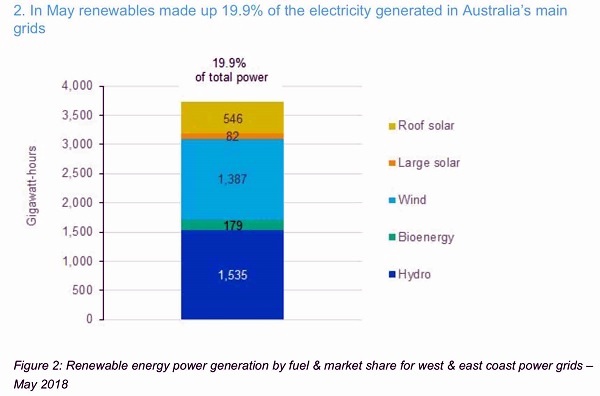
Actually, the latest National Electricity Audit from The Australia Institute, just out, shows renewables in the half year to June reaching nearly 19 per cent in the NEM, according to Potter. See also RenewEconomy.
Green Energy Markets found 5,542MW of renewables under construction:
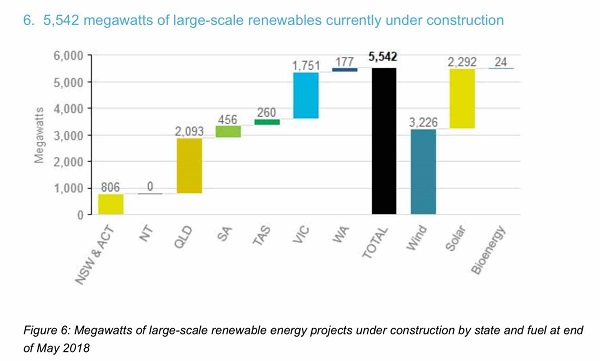
-
Queensland currently leads the country in terms of large-scale installations, with more than 2GW under construction, followed by Victoria, which has around 1.75GW under construction.
NSW can only muster less than half Victoria’s tally.
They found that Australia will end up with 33 per cent renewables by 2020, will likely get to 40 per cent by 2030, and has enough in the pipeline to reach 85 per cent:
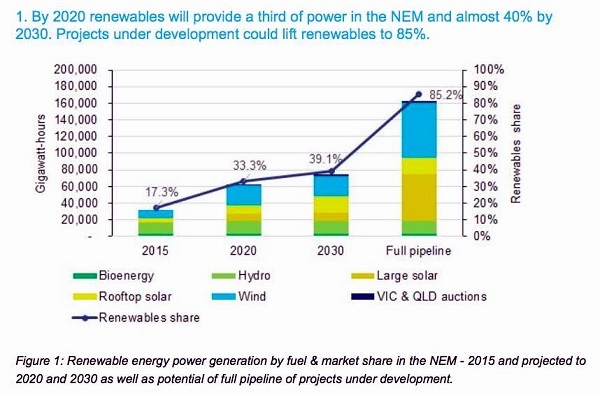
In the article linked at the head of the post Potter posts this table from Green Markets showing solar, wind and biofuel projects connected since January, under construction, committed or expected to be contracted under state auctions totalling 9 GW worth $16.4 billion, according to Tristan Edis from Green Energy Markets:

The same article tells us residential and small business rooftop solar installations combined in the half year totalled about 1.275GW, almost matching last year’s full-year record haul of 1.29GW. Customers are increasingly taking electricity generation into their own hands.
Prices have also fallen, remembering that generation forms roughly 25% of household bills:
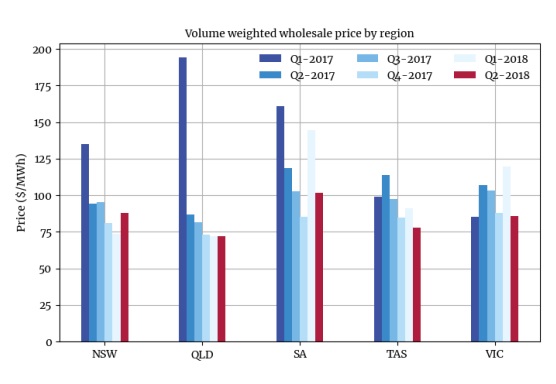
Funny that, when we are using ever more renewables.
I’ll just mention that the Queensland price spike in Q1 was found not due to gaming the system, in an investigation by the Australian Energy Regulator.
Frydenberg and Turnbull are claiming credit for the reduction in prices, citing their jawboning of the gas industry and retailers.
Jawboning retailers probably does not affect the wholesale electricity price. As to gas, I suspect the main factor is that we are using less of it as cheap renewable energy increasingly supplies the market.
Finally, there was, I thought, a stunning and noteworthy article by Giles Parkinson The changing shape of wind and solar in Australia’s grid.
Firstly, a number of projects under development are setting themselves up to become ‘baseload renewable energy projects’ by using wind, solar and some form of storage, so that they have completely instantaneous capacity to supply electricity as needed 24/7. Two such are Kennedy Energy Park and the Kidston project, both in North Queensland under the noses of some of the most rusted on ‘Coalsheviks’.
Secondly, there is a market for:
- the offering of “firming contracts” to those looking to source a significant amount of their supply from wind and solar, but wary of wholesale price risks when the sun don’t shine and the wind don’t blow.
These include “proxy revenue swaps” currently being marketed by Macquarie Capital.
The bottom line is that a significant manufacturing facility such as packaging giant Orora can strike a long-term power purchasing agreement which protects them from supply failure and price spikes.
It may be the first to use “proxy revenue swaps”, but this PPA:
- is just the latest in a spate of major corporate deals that have connected big industrial energy users like Sun Metals, the Laverton steel works, Telstra and miners and manufacturing groups in South Australia to wind and solar.
Some, like CUB, Mars Australia, and the University of Queensland, are going the whole hog and sourcing 100 per cent of their demand with renewables – often at stunningly low prices.
PPAs are struck directly with the generators, leaving out the retailers.
With all this going so swimmingly without a signed and sealed NEG there may be one brutal moment of political opportunity to head renewables off at the pass. That moment is now, although if you just looked at what was happening on the ground you would think the present momentum unstoppable.
Malcolm Turnbull once said he would not lead a party that wasn’t as committed to action on global warming as he was. His legacy to future generations is soon to be decided.
And we can only hope that Labor politicians don’t become complicit.

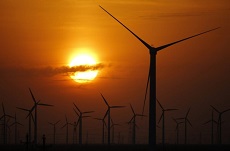
In this post I’ve concentrated on what is being said in the news pages of the AFR, which business leaders and politicians should be reading.
Brian (Re: The Nationals want coal):
Are you willing to pay $4 billion to support ‘clean’ coal-fired power plants? See the news.com.au article, dated April 3. link here. The article asks: How much will it cost? And then says:
I suspect this is what the “Coalsheviks” are basing their figures on.
But Ben Potter at AFR:
Are building new coal-fired power stations a bad idea?
The SMH had an article by Nicole Hasham, dated April 3, reporting a similar line, link here.
In other words, new coal needs to be subsidized by taxpayers in order to compete with renewables.
It appears new HELE coal plants will likely take 6 to 8 years to build and cost $3 billion per 1000 MW capacity. But there is also the recurring annual costs of fuel (ie. coal) to factor in the running costs.
Alternatively, solar thermal “power towers” take about 3 years to build. The South Australian project Aurora with 150 MW capacity with 8 hours energy storage reportedly costing $650 million. But the “fuel” (i.e. the sun) is zero cost. Recurring operating costs are therefore minimal.
It would be interesting to see where the project costs for solar thermal tech would possibly get to with say 6 generators built concurrently with 200 MW capacity with 17 hours storage each, dispersed over 3 sites (2 generators per site).
Meanwhile, recently in India, as Tim Buckley reports:
Among those who benefit from the obsession with coal-fired power, to the exclusion of all other sources of electricity, are the handful of rich dullards, the commissars of superannuation and investment funds and the political game-players. These are the obvious beneficiaries. A less obvious beneficiary is the nuclear power industry.
It is in the long-term strategic interests – but not the immediate and tactical interests – of the nuclear power industry to support, encourage and infiltrate the enthusiasts for coal-fired power. At a time of their own choosing, the nuclear power industry could launch their campaign to save us from the evil climate-change deniers and save us from dirty, dangerous, planet-threatening coal fired power and its nasty enthusiasts, (targets that are so easy to set up, so easy to blast away when the time comes). They would give us, instead, cheap, clean, reliable, SAFE!!!, koala-friendly, planet-saving nuclear power. Devious? Of course – but business is business. Would such a well-planned, well-directed and well-funded campaign really have a high probability of success? My oath it would.
Look out David Christensen, Matt Canavan, Tony Abbott, Josh Frydenberg and all you Libs and Nats who love coal-fired power, the Nukes might be coming after you – so beware of all donations and support, put a Geiger counter over any that come your way.
Graham Bell (Re: JULY 7, 2018 AT 7:10 AM):
Cheap? See Lazard’s Levelized Cost of Energy Analysis – Version 11.0, published Nov 2017, link here, and go to page 2, where you should see the Unsubsidized Levelized Cost of Energy Comparison. Nuclear can no longer compete on an economic basis with renewables (with energy storage included).
Clean? Very few people want a nuclear waste storage facility near them. I witnessed the strong local opposition first-hand to a proposed low & medium level nuclear waste facility at Hill End, NSW, at a few public meetings a few years ago. From Dr Finkel’s Independent Review into the Future Security of the National Electricity Market: Blueprint for the Future, published June 2017, on page 189, for nuclear energy:
Reliable? Large-scale nuclear generators are just as susceptible to high ambient temperatures as coal-fired generators – an increasing, ongoing risk with climate change.
Planet-saving? There simply isn’t enough high-grade uranium (and thorium) ores available to serve the world’s energy needs. Uranium and thorium are finite, non-renewable, one-time-use, and depleting resources. They are simply not sustainable for the long-term.
The overwhelming evidence I see suggests to me you are dreaming. Or are you being ironic?
Sorry, forgot to add the link.
Lazard’s Levelized Cost of Energy Analysis – Version 11.0, published Nov 2017, link here.
Global uranium ore supply:
See Fossil and Nuclear Fuels – the Supply Outlook, published by the Energy Watch Group, March 2013, link here, page 125, Figure 113.
Also, this report on the Energy Watch Group’s website titled The disaster of the European nuclear industry, dated March 2018, makes interesting reading:
GM,
As I read it, GB was not arguing that nuclear is cheap and clean.
I think he was suggesting its advocates would argue those would be its advantages.
For instance, James Lovelock advocates nuclear power.
And Northern Australia gas natural uranium. Win win for Northern Australia Development barrackers.
🙁
Ambigulous (Re: JULY 7, 2018 AT 2:32 PM):
So, you think/perceive GB is being ironic?
I don’t doubt advocates would try to argue “those would be its advantages“, but the evidence just doesn’t stack-up, as I’ve indicated above.
But I wonder whether GB is an advocate for nuclear energy, or were his comments above being ironic? The way I read it suggests he is an advocate, but I asked the question about being ironic to be sure of his intentions/meaning. I don’t think you can answer for him – only he can.
Geoff M. and Ambigulous:
No, no. I don’t think I’ve lost my marbles nor have I gone over to the dark side, (should that be the power outage side, perhaps?). Yes I was being partly ironic but also pointing out that a well-coordinated persuasion campaign would have you demanding more Thorium in your toothpaste and believing that the Easter Bunny will waft all Plutonium resides away.
I was in the middle of draughting sensible (in my opinion ) questions and comments about our current obsessions with electricity, to the exclusion of alternatives to electricity, when I lost the whole bloody lot ….
Now. Where was I?
Electricity and electronics have become so fashionable that we do overlook all the advances in mechanics, metallurgy, architecture, meteorology, human physiology, economics and a lot of other fields.
For example: Advances in these field mean that we can now build structures – from little cottages to huge factories and apartment blocks – with control of internal temperature and lighting built into them and near them. Enhance that with advantageous but non-traditional siting of the structure and you can have even better lighting and internal temperatures (just think about it as a 21st Century adaption of a sort of feng-shui ). The use of electricity is not abolished in such structures but it is no longer a dominant factor.
(I had better send this now before I lose it).
It is not being old-fashioned that keeps me using handsaws, brooms, pen-&-paper, books and other non-electronic devices. I do like the convenience of my electric and electronic devices but I simply do not allow them to control my life nor do I allow myself to become addicted to them. If a lot of others discovered the world of non-electric and non-electronic devices, then neither power companies nor political operators would have such a stranglehold on everything we do.
Cheers. 🙂
Agree, Graham.
Hand tools somehow keep the user closer to the materials. Not sure how to express it, but I don’t think this is a purely mystical belief.
Awareness of materials can be a deep knowledge that craftspersons develop. Potter with clays, glazes, kiln methods. Painters with papers, brushes, colour mixing…. Wood turner with timbers and countless special tools…. finding a piece of wood and taking it through to the finished article.
Builder re-purposes old bridge timbers or a red gum fence post. Wonderful results that honour the grain, colours and strengths of the wood.
Pens …. all the way to inscriptions and calligraphy.
I hope that youngsters with their screen time, will not lose that appreciation of the physical and natural world.
A butterfly or ant or tree or fish has more complexity and design features than we can conceive.
A granite benchtop is mere stone and has utility. I would hope most folk could also admire its beauty.
Boojwah to my bootstraps.
No apologies.
Australian conservatives have usually been supporters of nuclear power. Perhaps there is a fatal attraction of being able to have the means of becoming a nuclear power.
24/7 requirements do help the case for coal vs solar PV but solar thermal with molten salt storage and back-up molten salt heater can provide 24/7 or peaking as required.
Smoking coal is not good for the health.
Ambi, there is truth in beauty, and beauty in nature. I’m out of words, so I’ll leave it to the poets.
Danke schoen Brian.
Ambigulous:
Your words on being in touch with materials were apt, concise, clear and elegant. Well done!
No. Not boojwah nor mystical but truly Human.
John Davidson:
Definitely like your”Smoking coal is not good for the health.
It could be that some conservatives stick to coal-fired power and desire nuclear power because they seem familiar to them and are comfortable with them – even though the overall figures are starting to stack up against both forms of power generation.
Canavan: No for nuclear. Resources Minister won’t back the option because of waste and expense. from today’s “Morning Bulletin”, the Rockhampton paper circulated through Central Queensland.
Well, we shall see what we shall see ….
That was at the Qld LNP conference.
To do her justice, I think Deb Frecklington the parliamentary leader was a bit keen on renewables, seeing a large wind farm emerge in her electorate. Giles Parkinson is right about the party:
Ambigulous, bitte sehr!
Brian (Re: JULY 9, 2018 AT 10:02 PM):
So, does Michael McCormack wish to lead the Nationals and his supporters into extinction?
At Climate Code Red, dated yesterday, is a post by David Spratt headlined The straight-forward climate question Josh Frydenberg will not answer, link here, that includes (bold text my emphasis):
The report was not opposed by the government Senators on the inquiry committee.
Committee Membership:
Senator Alex Gallacher, Chair ALP, SA
Senator Linda Reynolds CSC, (from 5 February 2018)
Deputy Chair (from 7 February 2018) LP, WA
Senator the Hon Bridget McKenzie, (from 23 June 2017 to 5 February 2018)
Deputy Chair (from 14 July 2017 to 20 December 2017) NATS, VIC
Senator Chris Back, Deputy Chair (to 22 June 2017) LP, WA
Senator David Fawcett LP, SA
Senator Kimberley Kitching ALP, VIC
Senator Claire Moore ALP, QLD
Senator Rex Patrick (from 15 November 2017) CA, SA
Senator Scott Ludlam (to 14 July 2017) AG, WA
Senator Jacqui Lambie (from 9 August 2017 to 14 November 2017) JLN, TAS
Substitute member:
Senator Peter Whish-Wilson, AG, TAS substituted for Senator Rex Patrick
David Spratt says:
So, did Michael McCormack not get the memo from Senator Bridget McKenzie?
Peter Hannam in Fairfax reports on the rapid increase in rooftop solar installations across Australia, with business exceeding domestic.
Typical domestic setup is now 5kW.
(The much lower price now having a large effect?)
Geoff M, the ‘government’ does not seem to take much notice of senate committees, more is the pity, because they do some useful work.
I saw the Climate Code Red thing. Good to see Adam Bandt putting some pressure on.
Published yesterday, in RenewEconomy was an article by David Leitch headlined Is Rod Sims having a lend of us?, link here. David Leitch includes analysis of the ACCC report, including:
Actual coal costs paid by NSW generators:
This statement by Leitch caught my eye:
The Australia coal price chart is here for perspective.
Then there’s this statement:
The scenario for replacing NSW’s 2640 MW capacity Bayswater power station with a new coal-fired power station is a cracker.
Highly recommended for those who want to know the facts about how ludicrous is the idea of building new coal-fired power stations in Australia.
On today’ ABC Insiders programme, Federal Minister for Resources, Senator Matt Canavan, was being interviewed.
From time interval 16:46, Barry Cassidy asked:
Listen to the response from Canavan. It seems he was initially flustered.
Then at time interval 18:11, Barry Cassidy asks:
Part of Canavan’s response included:
I seems to me Canavan cares that coal (and gas) are fuel types that he thinks should be in Australia’s energy mix. Although later, panelist Katherine Murphy said she thought Canavan in the interview had wound-back the push for coal.
Later, from about time interval 37:13, David Pope says it would be unlikely that supercritical coal would be underwritten by the market as the energy supply price could be up to $94/MWh.
I thought Katherine Murphy was also making a lot of very good points.
Finally, it seems some sections of the media are beginning to wake up!
The Guardian article headlined Nationals leader pushes Queensland LNP to back Coalition’s energy policy, dated July 7, link here, includes:
Then there’s this article at Vox.com headlined Scientists assessed the options for growing nuclear power. They are grim., dated July 11, link here, including:
It seems new coal and nuclear options in Australia will need substantial subsidies to get any foothold. Renewables are reaching “subsidy independence”.
We know your view, you’ve shared it with us countless times.
Telling us again does not advance the discussion.
Jump (Re: JULY 15, 2018 AT 7:51 PM):
So, you would be willing to abolish the PBS and pay full price for medications (for you and your family)? You’d be willing to cut-up your Medicare card and pay full price for medical procedures and services (for you and your family)? You’d insist on trucking companies paying full wack for the damage they do to public roads that’s subsidized by the community (i.e. local, state and/or federal governments) and pay for any increased freight costs that may affect goods and services? These are just a few examples.
And how does the military fit in with your philosophy? Are you advocating abolishing the military and paying for mercenaries when Australia is threatened? Cops for hire, perhaps?
What about basic science research and institutions? Who pays, or we just don’t bother because there’s no apparent profit or useful applications that can be seen in it just yet?
I think your crude generalization shows no thought about the implications and consequences that would happen to the apparently comfortable world we live in here in Australia. I think it seems like a recipe for a banana republic – a much harder, harsher life for many.
Geoff M:
Geoff, Katherine Murphy works for Guardian Australia, who do OK on climate. Her boss, Lenore Taylor, is one of the best informed, and personally attended the Paris UNFCCC meeting in 2015.
Here’s Murphy:
Abbott is angry about energy but there are bigger fish to fry
Brian (Re: JULY 15, 2018 AT 11:46 PM):
Thanks for your link to Murphy’s Abbott is angry about energy but there are bigger fish to fry piece.
Below Murphy’s piece I scrolled down the comments and came across Jamie Smith’s rant (7 Jul 2018 17:28) that includes:
I think it’s extremely difficult to argue otherwise.
Today, the Australian Energy Market Operator released its Integrated System Plan 2018, link here.
Also today, at The Guardian there’s an article by Katherine Murphy headlined Renewables will replace ageing coal plants at lowest cost, Aemo says, link here, including:
Yet other sections of the media are emphasizing that coal will be required for years to come:
News.com.au article: AEMO report will ‘please’ pro-coal MPs
Australian Financial Review article: Prolong the life of coal-fired power stations in the National Electricity Market, says Australian Energy Market Operator
ABC.net.au article: Energy Market Operator warns coal must remain part of the mix for next 20 years
Interestingly, The Australian article headlined AEMO report ‘shows coal on the way out’: Greens, are taking that tack.
Geoff, the plain fact is that AEMO don’t make policy on emissions. However, they’ve stuck to modelling a ‘fast change’ scenario, based on the CSIRO work.
I think they are actually saying, don’t close coal down before you have planned replacement electricity. Their really big focus is on network planning.
Here are some more links:
Bandt press release – AEMO report shows only ‘6 coal-fired power stations’ will be left
Parkinson at RenewEconomy – AEMO: Cheapest way to replace coal is solar, wind, storage
Brian (Re: JULY 17, 2018 AT 11:06 PM):
Yesterday, Ross Greenwood interviewed a few people concerning yesterday’s release of the AEMO’s Integrated System Plan 2018. The interview podcast with AEMO Managing Director, Audrey Zibelman is here.
From time interval 3:55, Ross Greenwood, in his introduction, says (bold text my emphasis):
From time interval 7:33, Ross Greenwood asks:
Audrey Zibelman replied (bold text my emphasis):
I don’t think what Ross Greenwood is saying the AEMO is saying is what Audrey Zibelman is saying – existing coal is on the way out, retired at the end of engineered operating life (50 years) – no new coal.
I think Zibelman makes a lot of sense. Well worth a listen.
Then listen to Minister Josh Frydenberg talking with Ross Greenwood, yesterday, podcast here.
Geoff, I listened to both of those. With Frydenberg, we’ve heard it all before.
I think Zibelman is smart and knows what she’s doing, which she does in a very professional manner.
First up, she knows who she is working for – COAG, although a lot of pressure is coming from one member, ie the Commonwealth.
Secondly, she knows what her job is – to operate the market, not just day to day, but to take actions to make the market fit for purpose in the future.
She knows that it is not her job to set emissions policy.
I’m fed up with this ‘technology neutral’ stance of the government. Frydenberg says, we can’t be pro or anti coal. We are going to have to be anti coal if we are doing our duty by future generations.
Could it be that Minister Frydenberg aims to step back and let “the market” act, which in this case may arrive at financial and energy plans quite close to approaches involving rapid reductions in emissions for energy production, without explicitly stating that as his aim??? Or is that simply far too cunning to be his real purpose??
Well, not really ‘stepping back’. Snowy Hydro is an elephant sitting down in the sandpit, and may dampen a possible developing industry in pumped hydro in NSW, which would provide cheaper solutions, and depress the development of other forms of large-scale storage.
We’ll need to see the detail in the final NEG, but I’m expecting the bias will be in favour of not going beyond the low ambition of 26-28% which they want to lock in. This is preserving the place of existing coal.
Brian (Re: JULY 18, 2018 AT 11:19 PM):
I agree, and I’m thankful that she, and her team, have the intelligence and courage to provide frank and fearless advice to the nation for a roadmap for Australia’s long-term sustainable, affordable, and reliable electricity supply for the future.
Zibelman is confined by her position, and has to work with what she and her team have available to them. The least-cost plan outlined in the AEMO’s Integrated System Plan 2018 happens to enable substantial emissions reductions, but gas is also included. As I’ve said on numerous occasions, humanity needs to leave fossil natural gas, not just to mitigate dangerous climate change, but also because of a likely looming post- ‘peak gas’ world. But perhaps that was a bridge too far for the AEMO. At least the plan says unambiguously that there’s no room for new coal plants, and ageing existing coal plants are on the way out, although not as fast as they should. But as more renewables enter the market I suspect the remaining coal plants will become less profitable, which may prompt earlier retirements – the trick is to have sufficient replacement ‘firm’ generating capacity in place when they do.
I see this as a ‘dog whistle’ for the right wing of the COALition. New coal is no longer economically competitive – if the federal government is fair dinkum about low cost, reliable electricity for Australia, then they can’t support new coal plants – business is waking-up to this.
Dr Finkel’s Independent review into the future security of the National Electricity Market: Blueprint for the future, Energy Security Board Chair, Dr Kerry Schott’s public comments, the ACCC report released last week, and now the AEMO’s Integrated System Plan 2018, are consistent in their messages. I think the COALition ignores the evidence and recommendations provided by these ‘experts’ (appointed by the government) at their peril.
Of course, the voting public need to wake-up to what needs to be done and vote for the candidates at the next federal and state elections that support the energy technology transition – it’s up to Australian citizens to care about their own and their family’s futures.
Yes Brian
And on this blog John D has been unkind enough to describe Snowy 2.0 as more a photo opportunity than a serious prospect. Meanwhile our land abounds in hundreds of potential pumped storage sites.
Geoff M:
Today I heard Steve Austin on local radio interviewing a voter in the oncoming Longman byelection who resides at Woodforde, population 3,458, located 72 km NW of Brisbane and 24 km west of Caboolture, where she would have to go for serious shopping.
Her big thing was that no-one ever comes to ask them what they want.
No-one comes because the LNP will get their votes anyway (or ON or other crazies), and Labor wouldn’t bother because there aren’t many people there and they wouldn’t change their votes if they did come.
What did she want from the Commonwealth government? She wanted a bus service so she wouldn’t have to drive her car to go shopping, that’s what she wanted.
I despair about democracy sometimes.
Brian (Re: JULY 19, 2018 AT 9:25 AM):
In today’s SMH paper edition is an op-ed by John Hewson headlined Tender will allow Coalition to dig its way out of coal hole, link here. It includes:
That’s what the South Australian government did and the result was the SolarReserve solar thermal Aurora project, outbidding every other technology offered. But I wonder whether the right wing of the COALition really want a fair competitive bidding process – it will likely show their ideology is ill-founded.
Ambigulous (Re: JULY 19, 2018 AT 4:17 PM):
Er, you mean tens of thousands of potential pumped-hydro energy storage sites in Australia? 22,000, according to Professor Blakers, but Australia only needs about 20 off-river sites providing a total capacity of 20 GW of power output and about 450 GWh of energy storage to support 100% wind and solar-PV generation.
Yes Geoff
I couldn’t recall the figure. But if they are to be well spread out, each location optimised to lower construction costs and also lower transmission losses once built, we could come up with an agreed list of several hundred “better” sites.
Then some political/financial process to begin building. And as long as the short list had engineering and environmental approval, crikey: I wouldn’t mind too much if the last stage involved good old pork barrelling!
“If something worthwhile is done, it doesn’t matter who claims the credit”. (Or creams off a little benefit….) Just get the bl**dy things built!!
So who is going to issue the tender? AEMO, undewritten by the Feds, the Commonwealth government?
Will we see a Commonwealth takeover of a state function?
This might make sense in NSW/Vic/SA, but people south of the Tweed don’t understand the tropics.
Brian (Re: JULY 19, 2018 AT 10:56 PM):
And probably there are few opportunities where people are asked what they want/need. It seems to me, if the issue is important enough, then people should be taking the initiative and asking the politicians what policies they have, and what they can practically do, to help them – democracy requires voter/constituent participation/engagement.
Before relocating from Sydney, I had never experienced door-knocking from candidates in the lead-up to elections; just a few flyers in the letterbox, a few corflutes scattered around on power poles and front boundary fences, and ‘running the gauntlet’ of how-to-vote slips at the polling booths on election day. The Sydney electorates I was registered to vote in (both state and federal) were (and still are) blue ribbon Liberal, so it seems to me the incumbents didn’t work hard on the campaign trail, and the other candidates only put in a token effort, because the expectation was the incumbents would romp-it in – and they invariably did.
The electorates that I’m registered to vote in now – Bathurst (state) and Calare (federal) – aren’t as secure for the incumbent National party members, and it seems the election candidates work that little bit harder to capture votes.
I think democracy is only as strong as well-informed voter/constituent participation/engagement to keep politicians performing well. I reiterate: